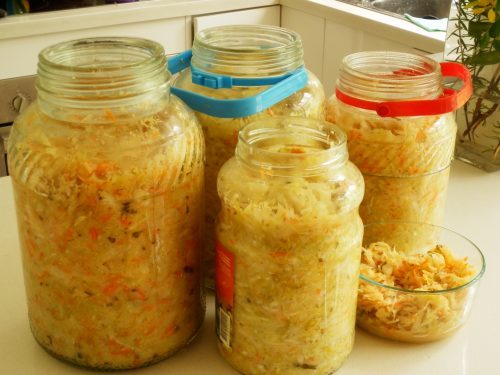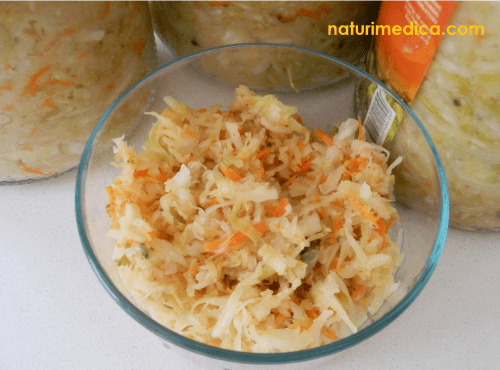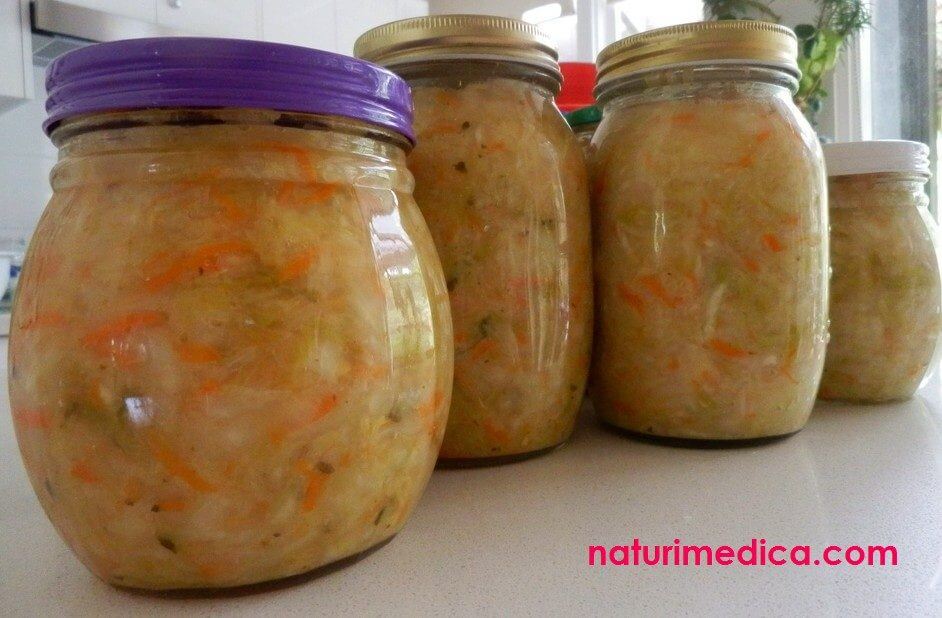I have been making sauerkraut for many years now using my Father’s delicious and unique sauerkraut recipe. My family used to make it together and in large quantities every autumn. It was fun, and making it now always brings fond childhood memories for me. Having made the sauerkraut once, you will see how easy is to do it and how little time it takes to prepare this wonderful, healing food as well as a proven remedy for so many ills! I made the latest batch recently and it’s one of the best ones so far (see the photos). Check out my well-tested, bullet-proof sauerkraut recipe below with photos to show the end result.
Why is sauerkraut so good for us?
Fermented foods are exceptionally high in nutrients and are the best natural probiotics available, with billions of good bacteria in just one tablespoon of sauerkraut, kefir and other fermented foods! Fermentation pre-digests the food making it easy for the gut to process and absorb, even by people with damaged guts and digestive problems. The process also releases nutrients from the food making them more bioavailable for the body. For example, sauerkraut contains 20 times more bio-available vitamin C than fresh cabbage, which has high vitamin C content as well. It’s important to know that only homemade sauerkraut has the healing properties. Virtually all commercially available sauerkraut have been pasteurised or processed in some way so it has a long shelf life. Unfortunately, pasteurisation kills the good bacteria we want. Therefore, to gain the many health benefits from eating sauerkraut, it must be made the traditional way and consumed raw.
Major benefits include:
- High potency original and natural probiotic, rich in enzymes and high in fibre. Balances the gut flora and drives out the parasites
- Supports the immune system (via increasing the beneficial flora) enabling it to better deal with any infections, cancer and numerous other diseases
- High in vitamins C and K – both essential for health including bones, joints and muscles
- Great for detox and cleansing
- Regular consumption over time will help to restore normal stomach acid production normalising digestion and fixing reflux thus eliminating the need for any harmful drugs

Here is my sauerkraut recipe – it has a truly unique flavour you’ll just have to experience for yourself!
Ingredients (for about two 1 litre jars or one bigger one) – use organic vegetables only
- 2 medium cabbage heads with the cores removed and finely shredded (the finer the better as more juice will be released faster). Reserve 3-4 large outer leaves to cover the sauerkraut once it’s in the jars
- 2-3 tablespoons of Celtic salt / sea salt
- 1-2 carrots finely shredded
- 1 onion finely shredded
- 5 whole peppercorns
- 2 all spice (1 for each jar)
- 2 small bay leaves (1 for each jar)
- 1 tsp of caraway seeds (optional)
Steps: - Start shredding/chopping the cabbage and transfer it to a large ceramic or glass bowl and sprinkle with the sea salt (do the transfer each time after you shred about half a cabbage). The salt helps to pull the water from the cabbage which creates the brine in which the sauerkraut will ferment.
- Add all other ingredients and mix well. Then start to knead the mix, best with your hands, until the volume decreases by half and the cabbage releases its juice. It may take 10-15 minutes to get the right consistency i.e. when the cabbage is just covered with the liquid. If after the thorough kneading there is not enough juice, you can add some water to the mixture.
- When kneading is done, tightly pack the cabbage into the sterilised jar(s) eliminating any air bubbles and making sure the cabbage is submerged in its juice at all times.
- When the jar is about 90% full, cover it with one or two outer cabbage leaf cut into pieces (as required), making sure the leaves are also submerged in the juice. Next, put some weight on top (such as a rock or a little jar with water) to keep the contents submerged during the fermentation. Important: if cabbage is exposed to the air, it will rot instead of fermenting.
- Cover the jars with plastic wrap with a few holes poked in it to let out the gases, and leave in room temperature for around 7-10 days (in warm weather, longer in colder conditions). Taste the cabbage after 5-7 days to see if it’s ready – it should be crunchy, tangy and mouth-watering. Once the sauerkraut tastes the way you like it, remove the stone and the outer cabbage leaves plus any scum that may develop as a part of the process (this is normal). Discard any parts of the leaves / sauerkraut that have any traces of the scum or any discoloured cabbage (usually the top layer). Trust your nose – if it smells and tastes OK, it most likely is.
Once fermentation is over, it’s best to keep it in the fridge to slow down further fermenting process, especially in the warm weather. It should keep for 2-3 months or longer but it never lasts that long in my place:).

Once you make the ‘basic’ sauerkraut you can start to create your own tasty blends adding other vegetables and herbs such as chilli, beetroot, radish, ginger, garlic, dill and parsley or seaweeds (e.g. wakame, kelp or dulse) to make it extra rich in minerals. If you add half a red cabbage to the mix whilst making a batch you’ll get a great looking and tasting pink mix. In fact you can make sauerkraut in many colours – add more carrots to make it orange or green herbs to create an emerald green blend. Happy sauerkraut making! Please let me know how you go in the comments section below. Do you have a great sauerkraut recipe? Share it in comments below! Check out my other fermented vegetables recipes for
beetroot kvass and vegetable mix. Best of Health
 Joanna Sochan
Joanna Sochan Wholistic Health and Lifestyle Therapist Natural and Lifestyle Therapies for Abundant Health and Wellbeing
Additional resources
 Joanna Sochan
Joanna Sochan is a Natural Therapist and founder of Naturimedica Holistic Health & Wellness. She has a passion for helping clients transform their lives by becoming healthy and well naturally. Joanna has 12+ years experience in clinical practice and has special interest in solving complex cases, functional medicine testing, gut health, sleep, fatigue and chronic pain. She guides clients through her tailored programs and eCourses as well as helping them individually (mostly online) Australia-wide.
View full bio.
 Print This Post
Print This Post 
 Once you make the ‘basic’ sauerkraut you can start to create your own tasty blends adding other vegetables and herbs such as chilli, beetroot, radish, ginger, garlic, dill and parsley or seaweeds (e.g. wakame, kelp or dulse) to make it extra rich in minerals. If you add half a red cabbage to the mix whilst making a batch you’ll get a great looking and tasting pink mix. In fact you can make sauerkraut in many colours – add more carrots to make it orange or green herbs to create an emerald green blend. Happy sauerkraut making! Please let me know how you go in the comments section below. Do you have a great sauerkraut recipe? Share it in comments below! Check out my other fermented vegetables recipes for beetroot kvass and vegetable mix. Best of Health
Once you make the ‘basic’ sauerkraut you can start to create your own tasty blends adding other vegetables and herbs such as chilli, beetroot, radish, ginger, garlic, dill and parsley or seaweeds (e.g. wakame, kelp or dulse) to make it extra rich in minerals. If you add half a red cabbage to the mix whilst making a batch you’ll get a great looking and tasting pink mix. In fact you can make sauerkraut in many colours – add more carrots to make it orange or green herbs to create an emerald green blend. Happy sauerkraut making! Please let me know how you go in the comments section below. Do you have a great sauerkraut recipe? Share it in comments below! Check out my other fermented vegetables recipes for beetroot kvass and vegetable mix. Best of Health  Joanna Sochan is a Natural Therapist and founder of Naturimedica Holistic Health & Wellness. She has a passion for helping clients transform their lives by becoming healthy and well naturally. Joanna has 12+ years experience in clinical practice and has special interest in solving complex cases, functional medicine testing, gut health, sleep, fatigue and chronic pain. She guides clients through her tailored programs and eCourses as well as helping them individually (mostly online) Australia-wide. View full bio.
Joanna Sochan is a Natural Therapist and founder of Naturimedica Holistic Health & Wellness. She has a passion for helping clients transform their lives by becoming healthy and well naturally. Joanna has 12+ years experience in clinical practice and has special interest in solving complex cases, functional medicine testing, gut health, sleep, fatigue and chronic pain. She guides clients through her tailored programs and eCourses as well as helping them individually (mostly online) Australia-wide. View full bio.  Print This Post
Print This Post 

Hello Joanna,
Can I make this Sauerkraut with out So much salt? My husband Cannot eat much salt, and I don’t like it.
How much Less salt would you recommend For this recipe ?
I Just want to mention, how I just connected The dots of Cabbage to my Ulcer going away.
Years ago when I was 15 , I had a Ulcer, not the type I could take the Antibiotic for.
Over 25 yrs ago a women told me To eat Cabbage, Raw or cooked, but eat red, green to get rid of my ulcer.
I ate it for a few months everyday. I do like cabbage But no more painful ulcer, and No more drug.
This worked for me.
I know for sure it’s gone as I was in the hospital at two different times for the test where the Dr. goes down with the light, and now it’s gone.
I’m a slim women , but my friends mother was Very
Heavy.
That said your sauerkraut Recipe should work the same on My daughters gut problem.
Can’t wait to make your Sauerkraut.
Btw Amazon sells wooden Tampers to get a good fermentation when making sauerkraut in large jars, and there easy to use.
Thank you,
Hello Annie
Thank you for your post. Yes, raw cabbage or juice is amazing for healing stomach ulcers as well as Helicobacter pylori infection.
Re the salt – it’s needed for good fermentation, extracting the juice and preservation of sauerkraut to last longer. If it’s too much for you, you can use half the amount of salt, it should also work well.
Hi Joanna…presumably OK to chop vegetables in a larger food processor? Cheers Colin
Yes, that a very good way to do that! Much faster that cutting it on the mandolin slicer I use:)
I made this recipe last weekend and put it in the fridge too early so I brought it back out for a few more days. I had a lot going on and had forgotten how long it was out fermenting for. It’s only now I recalled it was only a week ago! Will this ruin the fermentation cycle? I tasted it and it was still rather crunchy and very salty. Is it meant to be really salty, or did I overdo it? Do I rectify by tipped the salty water out and topping up with fresh water once it’s fermented? Thanks for any advice.
Hi Ani
Fermentation is going on in the fridge as well so it’s OK. You can keep going with fermenting the cabbage outside of the fridge until you like the texture and taste, then put it into fridge to slow the fermentation down.
Re the salt – sounds like you may have added too much of it, we all have different salt tolerance:) Make sure you use less next time. Yes, you can remove a bit of brine/ salty water (up to 1/4th of it) and then add fresh water and mix well to keep the cabbage from spoiling. Alternatively you can quickly rinse each portion of the sauerkraut in fresh water, keeping the liquid (it’s rich in good bacteria, you can dilute it with water to your taste and drink it as a probiotic drink).